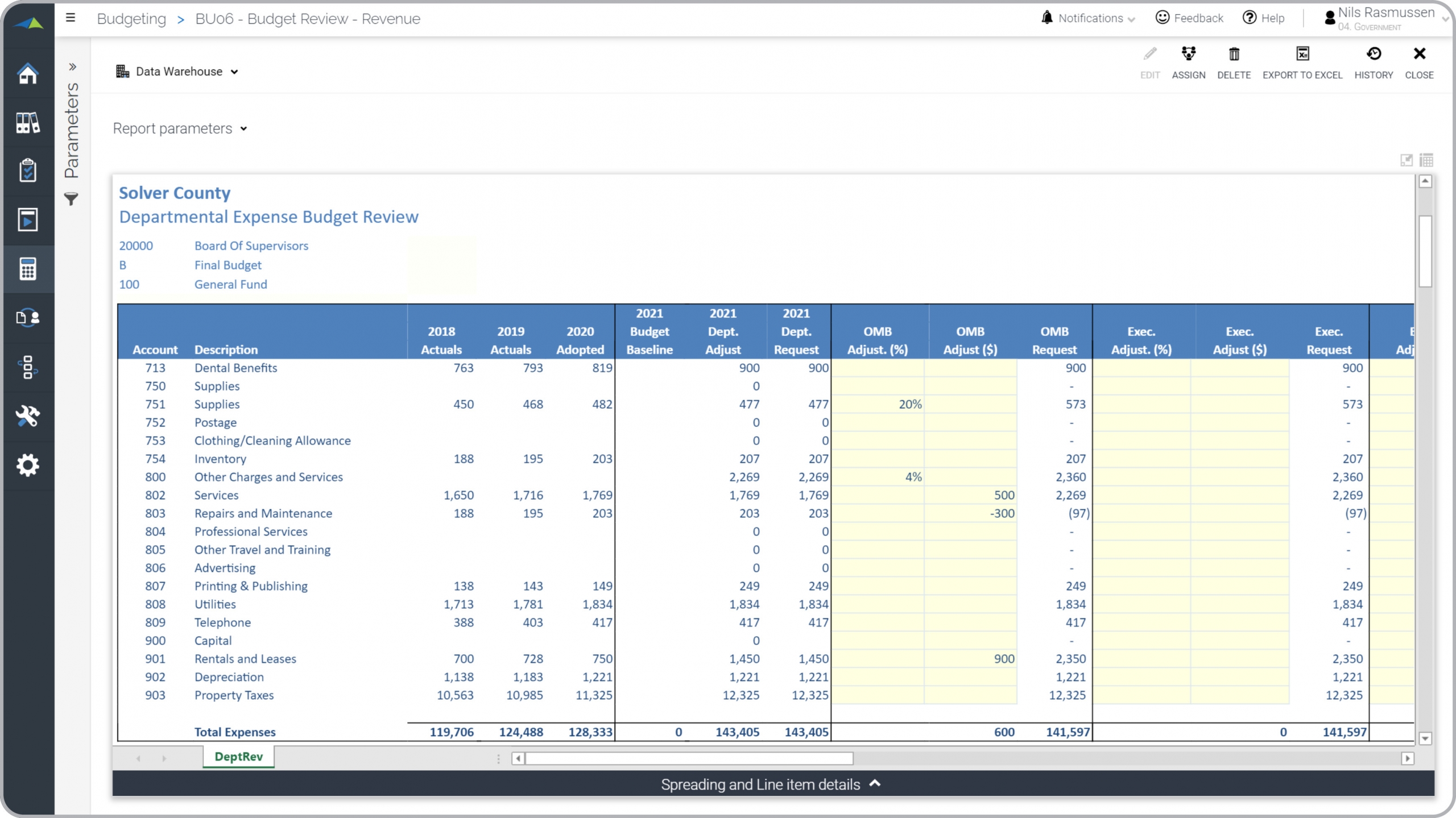Expense Budget Review and Adjustment Model for Government Organizations
What is an
Expense Budget Review and Adjustment Model
? Expense Budget Review and Adjustment models are considered a central part of annual budgets and are used by budget managers and reviewers to manage budget requests and historical data and to provide proposed adjustments. Some of the main functionality in this type of budget template is that it displays historical actual and budget expenses and provides input (yellow cells in the provided example) of proposed increases/decreases with commentary. The template shown in the screenshot below has the following information: 1) Two years of actual data, 2) Last year's adopted budget, 3) Baseline budget (often a copy of last year's adopted budget) and departmental adjustments which is added up to the department requested expense budget for the current annual budget process, 4) Amount and/or percent adjustments by the Budget Manager's Office, 5) Adjustments from the Executive office, and 6) Adjustments from the Board. Not visible in the screenshot are also comment input fields for each of the reviewers as well as Line Item Detail, Capex and Payroll input forms where users can enter and document each item that rolls up to a general ledger account. You find an example of this type of budget template below.
Purpose of
Expense Budget Review and Adjustment Models Public Sector organizations use Expense Budget Review and Adjustment Models to enable an efficient budget process with easy audits and automated workflow. When used as part of good business practices in Budgeting and Planning departments, a government entity can improve its expense budget accuracy, and it can reduce the chances that comments and adjustments are poorly communicated or lost during the budget process.
Example of a
Expense Budget Review and Adjustment Model Here is an example of an Expense Approval and Adjustment input form with text comments. [caption id="" align="alignnone" width="2560"]
 Example of an Expense Budget Review and Adjustment Model for Government Organizations[/caption] You can find hundreds of additional examples
here
Who Uses This Type of
Budget template
? The typical users of this type of budget template are: Executives, Budget Managers, department heads.
Other Reports Often Used in Conjunction with
Expense Budget Review and Adjustment Models Progressive Budgeting and Planning departments sometimes use several different Expense Budget Review and Adjustment Models, along with revenue input forms, employee (human capital) and headcount forms, capital (Capex) budget forms, budget analysis dashboards and other management and control tools.
Where Does the Data for Analysis Originate From? The Actual (historical transactions) data typically comes from enterprise resource planning (ERP) systems like: Microsoft Dynamics 365 (D365) Finance, Microsoft Dynamics 365 Business Central (D365 BC), Microsoft Dynamics AX, Microsoft Dynamics NAV, Microsoft Dynamics GP, Microsoft Dynamics SL, Sage Intacct, Sage 100, Sage 300, Sage 500, Sage X3, SAP Business One, SAP ByDesign, Acumatica, Netsuite and others. In analyses where budgets or forecasts are used, the planning data most often originates from in-house Excel spreadsheet models or from professional corporate performance management (CPM/EPM) solutions.
What Tools are Typically used for Reporting, Planning and Dashboards? Examples of business software used with the data and ERPs mentioned above are:
Example of an Expense Budget Review and Adjustment Model for Government Organizations[/caption] You can find hundreds of additional examples
here
Who Uses This Type of
Budget template
? The typical users of this type of budget template are: Executives, Budget Managers, department heads.
Other Reports Often Used in Conjunction with
Expense Budget Review and Adjustment Models Progressive Budgeting and Planning departments sometimes use several different Expense Budget Review and Adjustment Models, along with revenue input forms, employee (human capital) and headcount forms, capital (Capex) budget forms, budget analysis dashboards and other management and control tools.
Where Does the Data for Analysis Originate From? The Actual (historical transactions) data typically comes from enterprise resource planning (ERP) systems like: Microsoft Dynamics 365 (D365) Finance, Microsoft Dynamics 365 Business Central (D365 BC), Microsoft Dynamics AX, Microsoft Dynamics NAV, Microsoft Dynamics GP, Microsoft Dynamics SL, Sage Intacct, Sage 100, Sage 300, Sage 500, Sage X3, SAP Business One, SAP ByDesign, Acumatica, Netsuite and others. In analyses where budgets or forecasts are used, the planning data most often originates from in-house Excel spreadsheet models or from professional corporate performance management (CPM/EPM) solutions.
What Tools are Typically used for Reporting, Planning and Dashboards? Examples of business software used with the data and ERPs mentioned above are:
- Native ERP report writers and query tools
- Spreadsheets (for example Microsoft Excel)
- Corporate Performance Management (CPM) tools (for example Solver)
- Dashboards (for example Microsoft Power BI and Tableau)
Corporate Performance Management (CPM) Cloud Solutions and More Examples
July 4, 2021
TAGS:
Reporting,
Solver,
local,
report writer,
Microsoft,
template,
practice,
Acumatica,
Netsuite,
Finance,
public,
opex,
planning,
GP,
Government,
Business Central,
state,
excel,
ax,
forecast,
Budget,
Dynamics 365,
budgeting,
revenue,
Cloud,
Software,
Tableau,
SAP,
example,
best,
Sage,
BC,
D365,
fund,
NAV,
Intacct,
county,
city,
CPM,
report,
sector,
SL,
Management,
dynamics,
Power BI,
expense budget,
plan,
comments,
review,
approval,
budget adjustments

